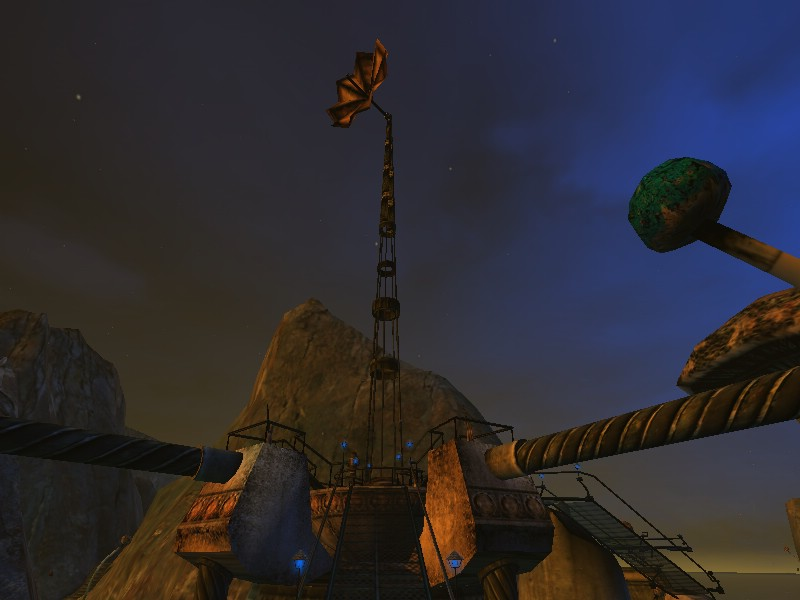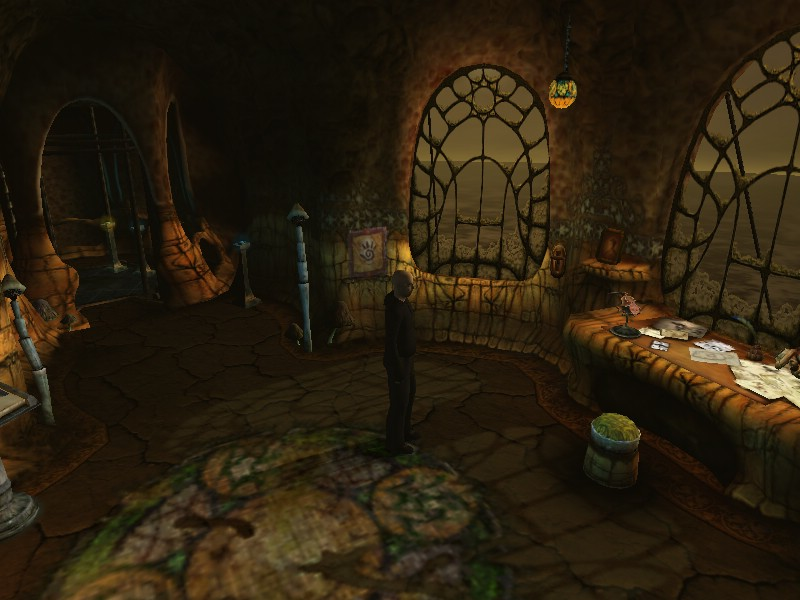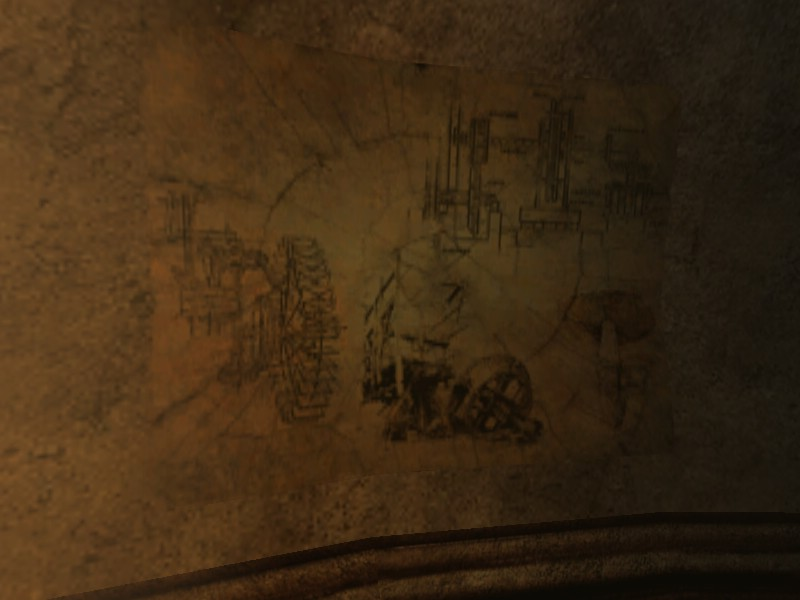Yeesha’s path is comprised of four Ages. I picked the first one at random, and like the Bevins, the Relto, and D’ni Ae’gura before them, I was taken aback by this Age’s beauty.
 The sun moves very fast through the sky in Teledahn. Or, rather, if what we understand about space and solar systems is correct, Teledahn spins on its axis very, very fast. The sun streaks through the sky, and you can track it from one horizon to the next, and then night falls. There are metal bridges over the swampy bay between – I kid you not – mushrooms the size of trees. I think that
The sun moves very fast through the sky in Teledahn. Or, rather, if what we understand about space and solar systems is correct, Teledahn spins on its axis very, very fast. The sun streaks through the sky, and you can track it from one horizon to the next, and then night falls. There are metal bridges over the swampy bay between – I kid you not – mushrooms the size of trees. I think that
 Here is the office of the DRC Restoration Engineer that was in charge of Teledahn. This is where the mystery of the Age, and its hidden use, starts to come forward. The ResEng was hit pretty hard by the politics in the DRC, and had even had contact with some returning D’ni. He had a thing for football, too. I guess it takes all kinds. Anyway, there are some interesting bits here in his office, but you don’t even get the juicy stuff until you get to his office back in Ae’gura (below). There, you find out about the DRC asking him to construct a weapon in the Age, as well as some hints about a second purpose for Teledahn, in the areas that the DRC hasn’t yet explored.
Here is the office of the DRC Restoration Engineer that was in charge of Teledahn. This is where the mystery of the Age, and its hidden use, starts to come forward. The ResEng was hit pretty hard by the politics in the DRC, and had even had contact with some returning D’ni. He had a thing for football, too. I guess it takes all kinds. Anyway, there are some interesting bits here in his office, but you don’t even get the juicy stuff until you get to his office back in Ae’gura (below). There, you find out about the DRC asking him to construct a weapon in the Age, as well as some hints about a second purpose for Teledahn, in the areas that the DRC hasn’t yet explored.
 In the hut where you link in, there is a grate in the floor. Finding this involved looking for something hidden in plain view, and boy, I shook my first at the D’ni when I figured it out. That was nothing compared to what I felt when I ventured down there. There were markings that anthropologists back home might call primitive in those tunnels. My preconceptions agreed with this… they looked like tribal drawings of people. People in chains. A D’ni prison? A prison for those “others” that the D’ni found already inhabiting their Ages? No, this was a prison for the Least, for the Bahro. One of Teledahn’s owners had trafficked in slaves, and it made me sick. Their arrogance had become just like their relatives in Tehranee, and they had fallen from their purpose in moving to D’ni Ae’gura in the first place.
In the hut where you link in, there is a grate in the floor. Finding this involved looking for something hidden in plain view, and boy, I shook my first at the D’ni when I figured it out. That was nothing compared to what I felt when I ventured down there. There were markings that anthropologists back home might call primitive in those tunnels. My preconceptions agreed with this… they looked like tribal drawings of people. People in chains. A D’ni prison? A prison for those “others” that the D’ni found already inhabiting their Ages? No, this was a prison for the Least, for the Bahro. One of Teledahn’s owners had trafficked in slaves, and it made me sick. Their arrogance had become just like their relatives in Tehranee, and they had fallen from their purpose in moving to D’ni Ae’gura in the first place.
 Many of the D’ni accomplishments felt tarnished to me now. I had no way of knowing which or how many were built upon the backs and labor of slaves. They had never been mentioned in any of the books or games about Atrus and his family, and he had blanched at use of human slavery when he discovered Tehranee. Did he even know about the Bahro? Did Gehn know, and not tell him? Or had the knowledge died with Aitrus, Anna’s husband? There was no way to know. I had always thought that the D’ni were just exceptional builders… exceptional stonemasons… exceptional writers. How much credit should go to the Bahro, instead? I had to know more. My urge to explore was still there, but for an entirely different reason. I had to find out if the D’ni civilization was even worth all of the work put into its restoration.
Many of the D’ni accomplishments felt tarnished to me now. I had no way of knowing which or how many were built upon the backs and labor of slaves. They had never been mentioned in any of the books or games about Atrus and his family, and he had blanched at use of human slavery when he discovered Tehranee. Did he even know about the Bahro? Did Gehn know, and not tell him? Or had the knowledge died with Aitrus, Anna’s husband? There was no way to know. I had always thought that the D’ni were just exceptional builders… exceptional stonemasons… exceptional writers. How much credit should go to the Bahro, instead? I had to know more. My urge to explore was still there, but for an entirely different reason. I had to find out if the D’ni civilization was even worth all of the work put into its restoration.
